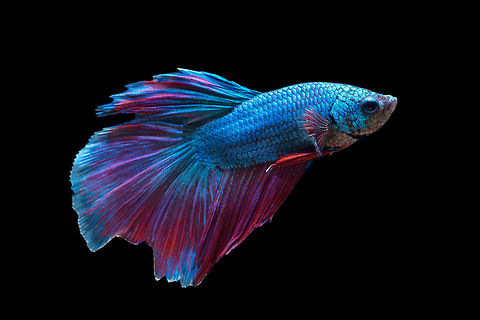
Appearance
'' B. splendens'' usually grows to an overall length of about 7 centimetres , including fins. Although known for their brilliant colors and large, flowing fins, the natural coloration of ''B. splendens'' is a dull green, browns and gray, and the fins of wild specimens are relatively short. Brilliantly colored and longer-finned varieties have been developed through selective breeding.Properly kept and fed a correct diet, Siamese fighting fish live about two to four years in captivity, and up to 10 years in rare cases.
The fish is a member of the gourami family of order Perciformes, but was formerly classified among the Anabantidae. Of the nearly 50 other members of the ''Betta'' genus, ''B. splendens'' is one of the most popular species among aquarium hobbyists.
''Betta'' species also prefer a warmer water climate than other tropical fish - around 25-30°C . They have an organ known as the labyrinth organ which allows them to breathe air at the water's surface. It is often wrongly thought that this organ allows the fish to be kept in unmaintained aquaria. This is a misconception, as poor water quality makes all tropical fish, including ''Betta splendens'', more susceptible to diseases such as fin rot.
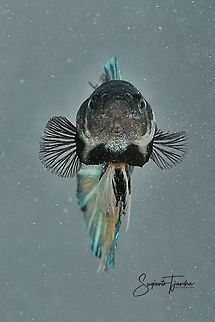
Naming
Although commonly called a betta, especially in North America, that is the name of a genus not only containing this fish, but also other species. ''B. splendens'' is more accurately called by its scientific name or Siamese fighting fish, to avoid confusion with the other species in the genus.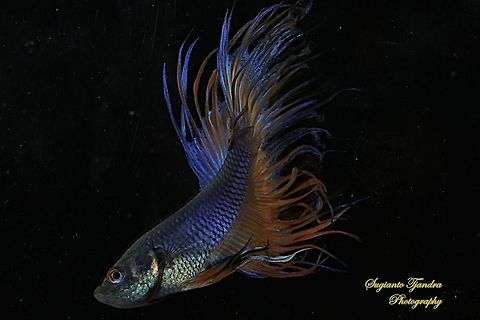
Behavior
Males and females flare or puff out their gill covers in order to appear more impressive, either to intimidate other rivals or as an act of courtship. Other reasons for flaring their gills is that they are startled by movement or change of scene in their environment. Both sexes will display horizontal bars if stressed or frightened; however, such a color change, common in females of any age, is very rare in mature males. Females often flare their gills at other females, especially when setting up a pecking order. Flirting fish behave similarly, with vertical instead of horizontal stripes indicating a willingness and readiness to breed . In fact the fish flare their fins and gills as a sign of aggression or flirting with other fish. Bettas sometimes require a place to hide, even in the absence of threats. They may set up a territory centered on a plant or rocky alcove, sometimes becoming highly possessive of it and aggressive toward trespassing rivals.The aggression of this fish has been studied by ethologists and comparative psychologists. These fish have historically been the objects of gambling; two male fish are pitted against each other in a fight and bets are placed on which one will win. One fish is almost always killed as a result. To avoid this, male Siamese fighting fish are best isolated from one another. Males will occasionally even respond aggressively to their own reflections in a mirror. Though this is obviously safer than exposing the fish to another male, prolonged sight of their reflection can lead to stress in some individuals. Not all Siamese fighting fish respond negatively to other male fish, especially if there are not many of them and they are in another tank. These are usually fish that have spent most of their life in a tiny container, surrounded by many other similarly abused individuals.
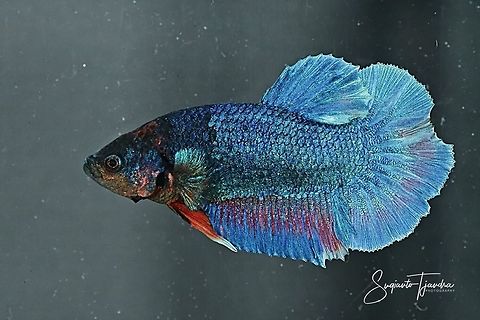
Reproduction
Male bettas flare their gills, twist their bodies, and spread their fins if interested in a female. The female will darken in colour, then curve her body back and forth as a response. Males build bubble nests of various sizes and thicknesses at the surface of the water.Plants or rocks that break the surface often form a base for bubble nests. The act of spawning itself is called a "nuptial embrace", for the male wraps his body around the female; around 10–40 eggs are released during each embrace, until the female is exhausted of eggs. The male, in his turn, releases milt into the water, and fertilization takes place externally. During and after spawning, the male uses his mouth to retrieve sinking eggs and deposit them in the bubble nest . Once the female has released all of her eggs, she is chased away from the male's territory, as she will likely eat the eggs due to hunger.
The eggs remain in the male's care. He carefully keeps them in his bubble nest, making sure none falls to the bottom, repairing the bubble nest as needed. Incubation lasts for 24–36 hours; newly hatched larvae remain in the nest for the next two to three days until their yolk sacs are fully absorbed. Afterwards, the fry leave the nest and the free-swimming stage begins. In this first period of their lives, ''B. splendens'' fry are totally dependent on their gills; the labyrinth organ which allows the species to breathe atmospheric oxygen typically develops at 3 to 6 weeks of age, depending on the general growth rate, which can be highly variable. ''B. splendens'' can reach sexual maturity at an age as early as 4–5 months.
''B. splendens'' can be hybridized with ''B. imbellis'', ''Betta'' sp.'' Mahachai'' and ''B. smaragdina'', though with the latter, the fry tend to have low survival rates. As well as these hybrids within the ''Betta'' genus, intergeneric hybridizing of ''Betta splendens'' and ''Macropodus opercularis'', the paradise fish, has been reported.
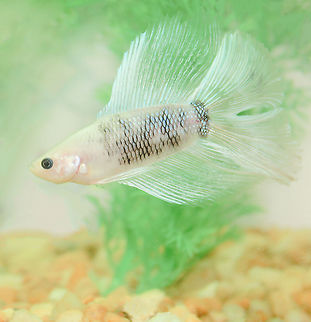
Food
Siamese fighting fish have upturned mouths and are primarily carnivorous surface feeders, although some vegetable matter may be eaten. In the wild, they feed on zooplankton, crustaceans, and the larvae of mosquitoes and other water-bound insects.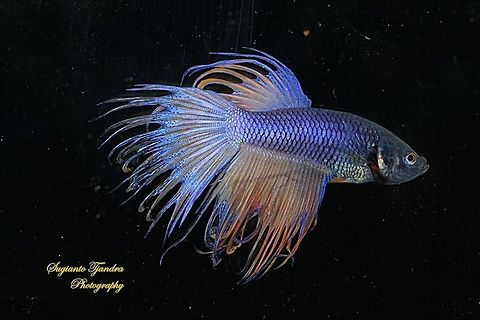
Evolution
The people of Siam and Malaya are known to have collected these fish prior to the 19th century from the wild.In the wild, bettas spar for only a few minutes or so before one fish backs off. Bred specifically for fighting, domesticated betta matches can go on for much longer, with winners determined by a willingness to continue fighting. Once one fish retreats, the match is over.
Seeing the popularity of these fights, the king of Siam started licensing and collecting these fighting fish. In 1840, he gave some of his prized fish to a man who, in turn, gave them to Dr. Theodor Cantor, a medical scientist. Nine years later, Dr. Cantor wrote an article describing them under the name ''Macropodus pugnax''. In 1909, the ichthyologist Charles Tate Regan, realizing there was already a species with the name ''Macropodus pugnax'', renamed the domesticated Siamese fighting fish ''Betta splendens''.
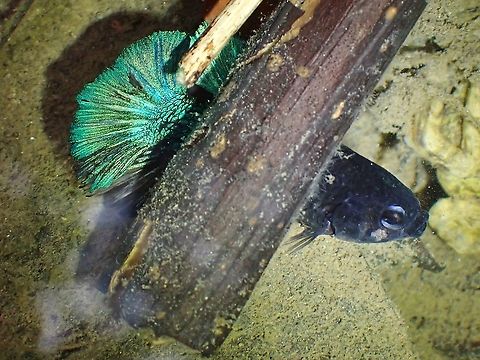
Cultural
* In the 1963 James Bond movie ''From Russia with Love'', the strategy of the criminal organization SPECTRE is compared to three Siamese fighting fish in the same tank: Two will fight each other to the death while the third will wait its turn to fight the exhausted victor, symbolizing the conflict between the USA and the Soviet Union, with SPECTRE as the fish that waits.⤷ The title of S.E. Hinton's 1975 novel ''Rumble Fish'', is an eponymous reference to what two brothers call the breed. In Francis Ford Coppola's 1983 film adaptation, everything appears in black and white except the Siamese fighting fish.
⤷ A 2006 episode of ''Cold Case'' features a boy with a pet Siamese fighting fish.
⤷ The Siamese fighting fish has been used as the default background in the beta and release candidate versions of the 2009 Windows 7 operating system, in an apparent reference to the name "Betta." A similar wallpaper and boot-screen also used in the pre-releases of Windows 8.
⤷ A Siamese fighting fish features as a clue in a murder in 2009 film ''Bad Lieutenant: Port of Call New Orleans.''
⤷ Milo, one of the main characters in the Disney Channel's 2010 series, ''Fish Hooks,'' is a Siamese fighting fish.
⤷ In the BBC children's series M.I.High, the plot of one episode involves causing the children to have their minds altered to that of a fighting fish by use of brainwaves distributed in a Van de Graaff generator.
References:
Some text fragments are auto parsed from Wikipedia.